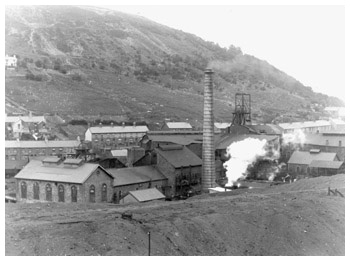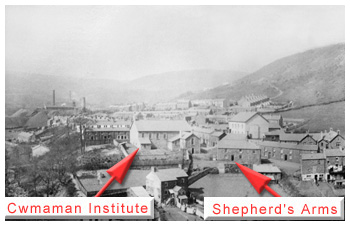
| Cwmaman | |
| In common with many communities in the South Wales Valleys, the village of Cwmaman developed to house and provide services for workers in the local collieries. Prior to the opening of the first collieries the Aman Valley was a peaceful rural area that contained only eight agricultural properties , all of which had existed since the late medieval period. Even as late as 1841, when new settlements had become well established around the Ironworks to the North around Aberdare and Hirwaun, the Aman Valley had a population of only 40 and still retained its traditional character. However the opening of the collieries in the mid Nineteenth Century led to a dramatic growth in both the population and number of buildings within the village. Many of the streets in Cwmaman such as Aman Street, Aman Place, Railway Row, Fforchaman Road and Kingsbury Place were all built between the years 1850 - 1860. | |
 |
The rapid and intense growth in the population of the village led to a growing need for public amenities. Public houses were opened, the first being the Shepherd's Arms which opened in 1850 and still serves the public today. Other public houses within the district included the Cwmneol Inn, the Globe Inn, the Ivy Bush Inn, the Mount Pleasant Inn and the Railway Inn. Numerous shops opened, a fact reflected by Kelly's Trade Directory for 1920, which contains over forty listings for retail establishments in Cwmaman, including greengrocer's, baker's, ironmongers, hairdressers and drapers. In addition to this Cwmaman had its own post office, established before 1875, and Public Hall and Institute, opened in 1892. Left: The Globe Inn c1900 |
Religion has also played its part within the community and a number of religious buildings have been opened to serve the community. The earliest of these being Moria Aman Welsh Congregationalist Chapel which opened in 1855, this was followed by Seion Welsh Baptist Chapel (1859), Soar Welsh Presbyterian Chapel (1859), Bethel English Primitive Methodist Chapel (1872/73), St. Joseph's Anglican Church (1880/81) and Trinity English Baptist Chapel (1901). In the photograph (right) a mother and her two children stand at the doorway of one of the miners houses in Fforchaman Row. Cracks in the rendering on the walls indicate the speed with which these houses were built - the building had not been allowed to settle prior to the application of the render. |
 |
| Cwmaman Coal Industry | |
| The Village of Cwmaman owes it's existence to the discovery during the early 19th century of rich coal seams within the district. It's growth is linked to the development of the steam coal industry and the three large scale collieries that once operated within the area. These collieries were: | |
 |
CWMNEOL COLLIERY: More commonly known as Morris Pit, this was the earliest colliery to be opened in the Cwmaman area. It was opened in 1848 by John and Charles Carr of Northumberland and Martin Morrison of Newport. This partnership retained ownership of the colliery until 1865 when it was sold to the Aman-Aberdare Coal Co. Ltd. Ownership of the colliery changed again in 1868 when the colliery was sold to the Powell Duffryn Steam Collieries Co. Ltd. , soon to become the largest coal combine in the world. They continued to operate the colliery until the nationalisation of the coal industry in 1947 when control of the colliery was given to the National Coal Board who closed the colliery in 1948. |
| CWMAMAN COLLIERY - Also known as Shepherd's Pit. The first shafts were sunk in 1849 with coal being found in December of that year. The colliery was founded by Thomas Shepherd in partnership with H. J. Evans, who later operated the colliery alone, until the Cwmaman Coal Company was formed to purchase the colliery in 1873. Expansion followed with the opening of the Fforchwen pit in 1900 and the Trewen Pit between 1910 - 1912. In 1918 the Cwmaman Coal Co. Ltd. sold their enterprise to D. R. Llewellyn, with further ownership changes occurring in 1928 and 1934 when it was owned by the Bwllfa and Cwmaman Coal Co. Ltd and Welsh Associated Collieries Ltd respectively. When the colliery closed in 1935 it was under the control of the Powell Duffryn Associated Collieries. |  |
 |
FFORCHAMAN COLLIERY - Also known as Brown's pit. Originally founded by James Brown and Thomas Prothero (& Co.) who obtained a lease to work the coal seams from the relevant owners in 1856. This partnership sold the Fforchaman Pit in 1864 to the United Merthyr Colliery Co. Ltd., who themselves sold the colliery to the Powell Duffryn Steam Coal Company in 1868. The colliery remained under their control until the nationalisation of the coal industry in 1947 and was closed by the National Coal Board in 1965. In addition to these major collieries two lesser and short lived ventures were attempted, these being the Fforchneol Colliery (1868-1893) and the Bedwlwyn Colliery (1865-1901). |
| Cwmaman Institute | |
| Probably the first lasting venture of its kind in the Cynon Valley, was opened in March of 1868. Originally opened as a reading room within a house provided rent-free by the Cwmaman Coal Company, it moved in 1881 to 10a Railway Terrace. In 1884 the workmen of Cwmaman Colliery agreed to a poundage scheme, whereby a half-penny in each pound of their wages would be deducted weekly in support of an expanded institution at the Tea Caddy Shop at numbers 130 and 131, Glanaman Road. | |
| This location soon proved to be insufficient and a building committee was appointed by a public meeting in 1889. A 99-year lease for land on the Cwmneol Estate was negotiated and an architect, Thomas Roderick of Clifton Street, Aberdare and builders, Messers Powell and Mansell of Cardiff were engaged. The completed building was formally opened by Lord Aberdare on the 25th January 1892 and included a public hall with seating for 700, reading rooms, a billiard room and a caretaker's cottage. Progress was temporarily halted when the building was destroyed by fire on the 19th April 1896. However restoration work was soon under way and the restored institute was completed by about January 1897. Later additions to the building were made in the shape of a lesser hall in 1906 and a single storey building in 1925.The Institute soon became the cultural centre of the community holding, eisteddfodau, Colliery Lodge meetings and becoming officially linked with the Cwmaman Brass Band in 1912. The library also prospered and by 1911 contained a total of 4,273 books: 3,679 in English and 594 in Welsh. |
|
| The depression years saw a dramatic decrease in income from the collier's poundage scheme and in the years 1920 - 1926 the institute lost almost 83% of its income from this source. Despite this and with the aid of grants from the Miners Welfare Commission the institute played a vital role in helping to alleviate the suffering of the community. Fund raising, providing food and carrying out political work became the main features of the institute at this time.The years following the Second World War were spent in reviving the cultural life of the community. This involved not only reviving established cultural activities such as the Institute Silver Band but introducing new innovations to accommodate the changes in social patterns and values evident after World war Two. These included the introduction of a public cinema in 1954 and the opening of licensed premises in 1967. Cultural activities were still encouraged and in particular live theatre productions began to flourish again, leading to the founding in 1972 of the Institute Theatre Group. In 1992/1993 extensive external restoration was made possible by a Welsh Office grant under its urban aid programme. Today the institute remains the busy centre of its community and although many of its functions have changed greatly it still holds firmly to the principles of community service. |
|
